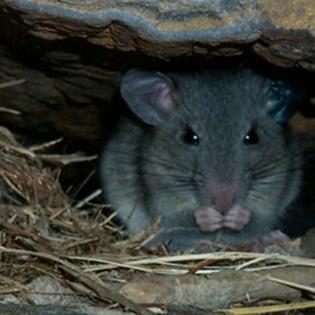To save the Allegheny woodrat, researchers schlep pounds of nuts
Published in Outdoors
While few profess a deep love for any small mammal with "rat" in its name, the Allegheny woodrat is a special case.
Pennsylvania Game Commission biologists, foresters and land managers recently have been lugging 25-pound bags of chestnuts to rocky hilltops in Fayette County and elsewhere to keep the state-threatened species alive.
Chinchilla-like with long furry tails, woodrats inhabit rocky outcrops in forested areas. The goal is to stabilize and grow populations to prevent them from becoming federally endangered.
The state has lost 70% of the known woodrat population since the mid-20th century. The species has completely disappeared from New York and Connecticut, said Katelyn Otterbein, a mammal recovery specialist with the Pennsylvania Game Commission, although there are small remnant populations left in New Jersey, Ohio and Indiana.
It's true, and perhaps a bit unfortunate, that the woodrat shares a name with the non-native Norway rat.
But the comparison ends there.
Woodrats are a little wilder. They are natives and are much less interested in humans or human food. Living exclusively in rocky areas, the woodrats in our region are found in the Allegheny Mountains, sharing a habitat with other specialists like timber rattlesnakes in a unique rocky community.
"These guys behave like the American pika out west," said Otterbein. "They create caches and collect food from late summer through the fall. They build a stockpile of food to get them through winter because they do not hibernate."
As a packrat, the woodrat also likes to collect shiny things like shotgun shells and rings, Otterbein said. Loners most of the time, they socialize only to breed, producing just one pup a year.
Chances are you won't see them — even if you venture into their rocky habitat. Woodrats are active mostly at night.
Compared to other rodent species, they are mild-mannered creatures, Otterbein said.
Woodrats play an ecological role in caching forest seeds, thus spreading them around. They are a vital part of the food chain as prey for owls, black rat snakes, raccoons and coyotes.
"The species is facing hard times," Otterbein said. "Our goal is to prevent them from becoming federally protected or extinct."
In an emergency action, the commission is feeding some of the remaining small pockets of the woodrats.
From December 2023 to February 2024, teams of Game Commission biologists, foresters, employees and others have been lugging 25-pound backpacks to spread 6,000 pounds of chestnuts in the forests, Otterbein said.
The chestnuts are deposited in deep crevices of rocks where the food will go specifically to woodrats and not other species, Otterbein said.
They are feeding woodrats at four sites in Fayette County, among about a dozen total sites in the state. The feeding program is in its sixth year.
And it's helping, Otterbein said. "The rats at the very least are not disappearing where we're feeding them," she said.
However, there are places in the state where they have just disappeared within one year.
Their plight and current status illustrate the myriad of problems faced by other species struggling with survival issues.
Driving the woodrat's population decline are roads and development that fragment the forest and their rocky habitat, in addition to deadly roundworms from the raccoon scat they collect for seeds.
Their food supply is shaky, too.
The demise of the American chestnut trees evaporated a bonanza of nuts — a major food source for many animals years ago. Now small mammals are grappling with the loss of acorns as oak tree die-offs are caused by the spongy moth.
Populations of the creatures are so sparse that the woodrats have begun inbreeding.
"We have a lot of things working against this little critter," Otterbein said.
The state Game Commission is consulting with a nutritionist and geneticist to collect woodrat dropping to analyze what they are eating.
"We're able to determine nutritional value with what is available. We work with land managers and foresters to get more mast-bearing plantings like oaks and berries that will benefit not just the woodrat, but provide more food to benefit the entire community of species that use those habitats."
The commission even brought in rocks to some areas to allow the woodrats to move and expand their footprint. The agency works with a captive breeding program with other states and the Association of Zoos and Aquariums.
This spring the plan is to introduce new genetically diverse individuals to the state's existing population. In addition, bait is being set out to deworm the raccoons living near woodrats.
The prognosis for saving this endangered animal is hopeful, Otterbein said. "We're seeing positive results from the feeding."
"Pennsylvania Game Commission biologists and forest land managers are coming together to work hard for the recovery of these species," she said.
The state's forestry bureau within the Department of Conservation and Natural Resources is working with the Game Commission to provide more mast-producing trees and shrubs near woodrat areas.
The Bureau of Forestry manages more than 2 million acres of public land in Pennsylvania.
The state has been cutting trees to open up the understory to sunlight, which gives oak trees as well as elderberry and blueberry shrubs the chance to grow, said Aura Stauffer, a wildlife biologist with the bureau. Stauffer is headquartered in Harrisburg.
Woodrats live in open rock field areas. "It's not an easy place to navigate," she said. "It's hard to plant in not a lot of good soil and deer will eat everything you plant often."
Given the slow rate of population growth as well as the time to increase beneficial trees and plants near woodrat populations, recovery won't be fast or even achieved in 10 years, Otterbein said.
"There are signs we are hitting the nail on the head with actions to stabilize the populations, which allows us to develop methods and tools into the future."
The Game Commission's woodrat program currently costs about $77,000 annually. Federal State Wildlife Grants from the U.S. Fish and Wildlife Service reimburses the commission for 65% of the program's cost, leaving state funds to cover about $27,000, said Travis Lau, press secretary for the commission.
The Federal State Wildlife Grants support state efforts to recover species in decline to prevent federal endangered or threatened species listings, according to the Game Commission.
Dropping in food to the woodrat is not a long-term solution, Otterbein said.
"Their habitat needs to be more productive with the food," she said.
"It takes years for oaks and hickory trees to produce plentiful masts. It's a process that involves a lot of people with a lot of specialties."
(c)2024 the Pittsburgh Post-Gazette Distributed by Tribune Content Agency, LLC.







Comments